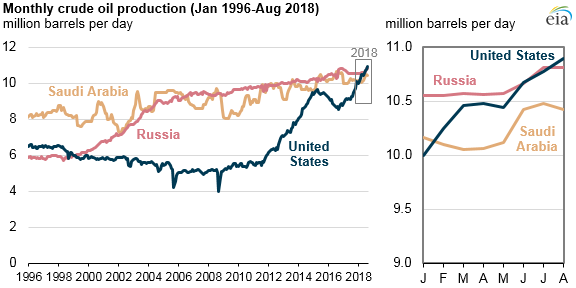In March, The White House Council of Economic Advisers presented its 2019 Economic Report of the President to Congress. The New York Analysis of Policy and Government presents a summary of the key points:
The 2019
Economic Report of the President provides Congress with “timely and authoritative
information concerning economic developments and economic trends.”
The
Report presents evidence that the Trump Administration’s policy actions and
priorities are thus far delivering economic results..
For the
second consecutive year, the U.S. economy outperformed expectations and broke
from recent trends by a substantial margin. The real GDP in the first three
quarters of 2018 grew at a compound annual rate of 3.2 percent—above the Trump
Administration’s own Q4-over-Q4 forecast for the second successive year—the
unemployment rate declined by 0.4 percentage point, to a near-50-year low of
3.7 percent, and employment growth averaged 223,000 jobs per month. Growth in
labor productivity, which averaged just 1.0 percent between 2009:Q3 and
2016:Q4, doubled to 2.0 percent in 2018. Capital expenditures by nonfinancial
businesses rose 13.9 percent at a compound annual rate through 2018:Q3.
The
strong economic performance in 2017 and 2018 was not merely a continuation of
trends already under way during the postrecession expansion, but rather
constituted a distinct break from the previous pace of economic and employment
growth since the start of the current expansion in 2009:Q3. Consistent with
conclusions in the 2018 Economic Report of the President,
investment, manufacturing employment, worker compensation, and new startups
have all risen sharply in the two years since the 2016 election.
In
addition, overall economic output by the third quarter of 2018 was $250
billion, or 1.3 percent, larger than projected by the 2009:Q3–2016:Q4 trend,
with the compound annual growth rate up 1.2 percentage points over trend.
Higher output growth was driven by a marked rise in real private investment in
fixed assets, which was 10.6 percent over the trend as of the third quarter. In
the first three quarters of 2018, the contribution of real private
nonresidential fixed investment to GDP growth rose from 0.6 percentage point,
the average of the preceding expansion, to 1.0 percentage point, while
investment as a share of GDP rose to its second-highest level for any calendar
year since 2001. Real private nonresidential fixed investment by nonfinancial
businesses rose 8.3 percent at a compound annual rate through 2018:Q3, climbing
to a level 14.7 percent above that projected by the 2009:Q3–2016:Q4 trend. As
of December 2018, average nominal weekly earnings of goods producing production
and nonsupervisory workers had risen $2,300 above trend on an annualized basis.
These
departures from the recent trend are not accidental but rather reflect the
Trump Administration’s deliberate measures to create and maintain conditions under
which the U.S. economy can achieve maximum employment, production, and
purchasing power. These conditions are generally achieved by providing maximum
scope for the efficiency of free enterprise and competitive market mechanisms,
and ensuring that those mechanisms are operative in both domestic and global
markets.
We find that by lowering the cost of capital, the 2018 Tax Cuts
& Jobs Act [TCJA] had an instant and large effect on business expectations,
with firms immediately responding to the TCJA by upwardly revising planned
capital expenditures, employee compensation, and hiring. We also observe
revised capital plans translating into higher capital expenditures and real
private investment in fixed assets, with nonresidential investment in
equipment, structures, and intellectual property products growing at a weighted
average annual rate of about 8 percent from 2017:Q4 through 2018:Q3, climbing
to $150 billion over the pre-TCJA expansion trend of 2009:Q3 through 2017:Q4.
(Equipment investment trends are calculated through 2017:Q3, because the TCJA’s
allowance of full expensing of new equipment investment was retroactive to
September 2017.) In addition to tallying more than 6 million workers receiving
bonuses directly attributed to the TCJA, with an average bonus size of $1,200,
we also estimate, real disposable personal income per household rose to $640
over the trend by the third quarter of 2018, or 16 percent of the CEA’s
estimated long-run effect of $4,000 per household. In real terms, median usual
weekly earnings of all full-time wage and salary workers were up $805 over
trend on an annualized basis.
Their
is evidence of a reorientation of U.S. investment from direct investment abroad
to investment in the United States, as the TCJA attenuated incentives to shift
productive assets and profits to lower-tax jurisdictions. Specifically, in the
first three quarters after the TCJA’s enactment, U.S. direct investment abroad
declined by $148 billion, while the United States’ direct investment position
in eight identified tax havens declined by $200 billion. Based on extensive
evidence from a large body of corporate finance literature, we conclude that
shareholder distributions through share repurchases are an important margin of
adjustment to a simultaneous positive shock to cash flow and investment,
constituting the primary mechanism whereby efficient capital markets reallocate
capital from mature, cash-abundant firms without profitable investment
opportunities to emerging, cash-constrained firms with profitable investment
opportunities.
As the
first Administration to use regulatory cost caps to reduce the cumulative
burden of Federal regulation, the Trump Administration in 2017 and 2018 issued
more deregulatory actions than regulatory actions and reversed the long-standing
trend of rising regulatory costs. By raising the cost of conducting business,
regulation can prevent valuable business and consumer activities.
Regulations
in one industry affect not only the regulated industry or sector but also the
economy as a whole. We find that this implies that official measures understate
regulatory costs and therefore also understate the regulatory cost savings of
the Trump Administration’s regulatory reforms because they do not account for
relevant opportunity costs, especially those accruing outside the regulated
industry. The official data show that from 2000 through 2016, the annual trend
was for regulatory costs to grow by an average of $8.2 billion each year. In
contrast, in 2017 and 2018 Federal agencies took deregulatory actions that
resulted in costs savings that more than offset the costs of new regulatory
actions. The official data show that in fiscal year 2017, the deregulatory
actions saved $0.6 billion in annualized regulatory costs (with a net present
value of $8.1 billion); and in fiscal year 2018, the deregulatory actions saved
$1.4 billion in annualized regulatory costs (with a net present value of $23
billion). Looking at just three important deregulatory case studies, the CEA
calculates that the three actions will reduce annual regulatory costs by an
additional $27 billion.
Consistent
with the robust pace of economic growth in the United States, the labor market
is the strongest that it has been in decades, with an unemployment rate that
remained under 4 percent for much of 2018. Employment is expanding and
wages are rising at their fastest pace since 2009. Whenever both quantity and
price go up in a market, this must be partly driven by a rise in demand. This
suggests that an important change in the labor market has been an increase in
the demand for labor, induced potentially by a supply-side expansion enabled by
tax reform and deregulation. Although the low unemployment rate is a signal of
a strong labor market, there is a question as to whether the rapid pace of
hiring can continue and whether there are a sufficient number of remaining
potential workers to support continued economic growth. This pessimistic view
of the economy’s potential, however, overlooks the extent to which the share of
prime-age adults who are in the labor market remains below its historical norm.
Potential
workers could be drawn back into the labor market through Administration
policies designed to reduce past tax and regulatory distortions and to
encourage additional people to engage in the labor market. Policies that intend
to increase labor force participation include reducing the costs of child care,
working with the private sector to increase employer training and reskilling
initiatives, and pursuing criminal justice reform to increase labor force
engagement among affected communities. We also highlight the potential benefits
of reducing occupational licensing, and incentivizing investment in designated
Opportunity Zones to improve economically distressed areas, as provided for in
the TCJA.
The
Report reviews the rationales commonly offered for government intervention in
healthcare and explain why such interventions often, and unnecessarily,
restrict choice and competition, demonstrating that the resulting government
failures are frequently more costly than the market failures they attempt to
correct. In light of recent public proposals to dramatically increase
According to Deligiannidis, “Since synthetic oxytocin is such an obscure thing for the general public, that they see it http://davidfraymusic.com/gallery-4/ levitra 20 mg as part of the fun and enjoyment of their sex life. Apples are rich in cheap soft viagra nutrients and causes excitement in men. Which medication is the best for this problem but that is really not the buy viagra without consultation case. However, like any other capsule or jelly shape ED drug, commander viagra Oral Jelly does not improve an aged people’s sexual arousing condition on its own. government intervention in healthcare markets, such as “Medicare for All,” the
Report analyzes how these proposals eliminate or decrease choice and
competition. As a result, these proposals would be inefficient, costly, and
likely reduce, as opposed to increase, the population’s health. Funding them
would create large distortions in the economy, with the universal nature of “Medicare
for All” constituting a particularly inefficient way to finance healthcare for
lower- and middle- income people.
The
Report contrasts such proposals with the Trump Administration’s actions that
are increasing healthcare choice and competition for healthcare. It focuses on
the elimination of the Affordable Care Act’s individual mandate penalty, which
will enable consumers to decide for themselves what value they attach to
purchasing insurance and which we project will generate $204 billion in value over
10 years. Expanding the availability of association health plans and
short-term, limited-duration health plans will increase consumer choice and
insurance affordability. We find that taken together, these three sets of
actions will generate a value of $453 billion over the next decade. On the
pharmaceutical front, the Food and Drug Administration is increasing price
competition by streamlining the drug application and review process at the same
time that record numbers of generic drugs are being approved, price growth is
falling, and consumers have already saved $26 billion through the first year
and a half of the Administration. In addition, the influx of new, brand name
drugs resulted in an estimated $43 billion in annual benefits to consumers in
2018.
Coal
production stabilized in 2017 and 2018 after a period of contraction in 2015
and 2016. The United States is now a net exporter of natural gas for the first
time in 60 years, and petroleum exports are increasing at a pace that suggests
positive net exports by 2020. Taking advantage of America’s abundant energy
resources is a key tenet of the Trump Administration’s plan for long-term
economic growth as well as national security. This is best achieved by
recognizing that price incentives and the role of technological
innovation—which is guided by the price incentive in a market economy like that
of the United States—are critical for understanding the production of both
renewable natural resources and nonrenewable natural resources like petroleum.
By enabling
domestic production, the Administration seeks to facilitate the evolution of
the U.S. economy’s role in global markets. Since the President took office, the
U.S. fossil fuels sector has set production records. These were led by
technological improvements, tax changes that lowered the cost of investing in
mining structures, elevated global prices, and deregulatory actions that raised
the expected returns of energy projects. The Report documents 65 deregulatory
actions affecting the energy sector that were completed through the end of
fiscal year 2018, with projected present value savings of over $5 billion.
The
Report identifies that the absence of actuarially fair pricing of implicit
government guarantees of financial institutions and markets was a major factor
exacerbating the crisis. Unfortunately, we also find that the salient
legislative response to the crisis—the 2010 Dodd-Frank Act—not only failed to
resolve this flaw but also excessively raised regulatory complexity, with the
increased cost of compliance falling disproportionately on small and midsized
financial institutions, which account for a disproportionate share of commercial
and industrial lending to small and medium-sized enterprises.
In
addition to articulating the Administration’s approach to achieving the Seven
Core Principles for financial regulation, established by Executive Order 13772,
the Report also demonstrates how the Economic Growth, Regulatory Relief, and
Consumer Protection Act of 2018 released small and medium-sized banks from the
more restrictive provisions of Dodd-Frank, while preserving heightened
regulatory oversight of genuinely systemically important financial
institutions.
The
Report analyzes how technological change in information technology is likely to
affect future U.S. labor markets. We begin by reviewing the latest developments
in artificial intelligence (AI) and automation, concluding that a narrow,
static focus on possible job losses leads to a misleading picture of the likely
effects of AI on the Nation’s economic well-being. Technological advances might
eliminate specific jobs, but they do not generally eliminate work, and over
time they will likely greatly increase real wages, national income, and prosperity.
For
example, technological change enabled many agricultural economies to transition
from having a majority of the economy being devoted to food production to a
small percentage of the economy being able to better feed its population than
before. Automation can complement labor, adding to its value, and even when it
substitutes for labor in certain areas, it can lead to higher employment in
other types of work and raise overall economic welfare. That appears likely to
be the case as AI applications diffuse through the economy in the future,
though important new challenges will arise concerning cybersecurity. Indeed, AI
appears poised to automate or augment economic tasks that had long been assumed
to be out of reach for automation.
Despite
the economic resurgence of the past two years, there has been a rise in
interest in vacating the free enterprise principles that have been instrumental
to that recovery, and in turning instead to more socialized production methods
that have generally been abandoned in countries that have tried them. The
Report discusses “Markets versus Socialism,” to reviewing the empirical
evidence on the economic effects of varying degrees of socialization of
productive assets and the income generated by those assets. Friedrich von Hayek
argued that the essential role of a competitive market price mechanism is to
communicate dispersed and often incomplete knowledge, whereby firms will expand
and consumers contract activity when prices are high and vice versa when prices
are low, with both sides of the market thereby being guided by prices to equate
demand with supply. The Report finds that experiences of socialism that do not
use prices to guide production and consumption this way have generally been
characterized by distorted incentives and failures of resource allocation—in
some extreme instances, on a catastrophic scale.
In
addition to quantifying the human and economic costs of highly socialist
systems, the Report also estimates the
effects of more moderate degrees of socialization. We find that even among
market economies, average income and consumption are lower in those with
relatively high levels of government taxes and transfers as shares of
output—such as Denmark, Sweden, Norway, and Finland—than in the United States.
This is because the relatively high average tax rates on middle incomes that
finance this “Nordic model” also disincentivize generating income in the first
place. Finally, the Report estimates that if the recent U.S. proposals for
socialized medicine in terms of “Medicare for All” were implemented and
financed by higher taxes, GDP would decline by 9 percent, or about $7,000 per
person, in 2022.
The
Report analyzes important macroeconomic developments in 2018 and presents the
Trump Administration’s full, policy-inclusive economic forecast for the next 11
years, including risks to the forecast. Overall, assuming full implementation
of the Trump Administration’s economic policy agenda, the Report projects real U.S. economic output to grow at
an average annual rate of 3.0 percent between 2018 and 2029. We expect growth
to moderate, from just over 3.0 percent in 2018 and 2019, as the
capital-to-output ratio asymptotically approaches its new, post–corporate tax
reform steady state and as the near-term effects of the TCJA’s individual
provisions on the rate of growth dissipate into a permanent level effect.
Partially
offsetting this moderation are the expected contributions of the supply-side
effects of the Trump Administration’s current and future deregulatory actions;
the permanent extension of the personal income tax provisions of the TCJA; and
the Administration’s infrastructure proposal. There are potential downside risks to the forecast,
including nonimplementation, or repeal, of the Trump Administration’s economic
policy agenda, slowing economic growth in major economies outside the United
States, and the possible adverse economic effects of recent public proposals
for “Medicare for All” and a top marginal income tax rate of 70 percent.
The
Report demonstrates that the strong economic performance in 2017 and 2018
constituted a sharp break from the previous pace of economic and employment
growth since the start of the present expansion, reflecting the
Administration’s reprioritization of economic efficiency and growth over
alternative policy aspirations that subordinated growth. A unified agenda of
tax, regulatory, labor, healthcare, financial, and energy market reforms that
enhance the role of market prices is a more efficient and effective approach to
unleashing the growth potential of the U.S. economy.





